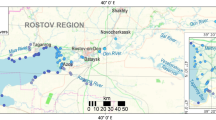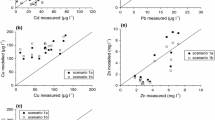Abstract
In this experiment, the effects of the Hungarian red mud disaster were studied in a soil column experiment focusing on element solubility. The effect of flooding with the highly alkaline red mud suspension and the effect of the percolation of precipitation water through the 10 cm thick red mud layer were modelled separately. Both scenarios affected the soil pH up to a depth of 80 cm. An increase in the total element concentration was only observed for Na and Mo, probably due to the leaching of red mud particles measuring 0.05–0.02 and <0.002 mm in the column. At the same time, the water-soluble concentrations of the potentially toxic elements As, Co, Cr, Cu, Ni, Pb, and Zn rose, at least in the top soil layer, but the concentration values remained below the limit values laid down by quality standards. Over a longer period of time, the main environmental risk raised by the disaster is the secondary salinization of the area.






Similar content being viewed by others
References
240/2005. (X. 27.) Government Order On the announcement of modifications in the control of transboundary movements of hazardous wastes and their disposal (Basle Convention). Magyar Közlöny. 2005/142. sz. 7789-7811.
50/2001. (IV. 3.) Government Order. On the rules of agricultural use and treatment of wastewater and sewage sludge. Magyar Közlöny. 2001/39. sz. 2532.
6/2009. (IV. 14.) KvVM-EüM-FVM common order about the standard limits and measurement of contamination for the protection of underground water and geological medium. (In Hungarian) Magyar Közlöny 51: 14398–14414.
Adriano, D. C. (1986). Trace elements in the terrestrial environment. New York: Springer.
Alva, A. K., Huang, B., Paramasivam, S., & Sajwan, K. S. (2002). Evaluation of root growth limiting factors in spodic horizons of Spodosols. Journal of Plant Nutrition, 25(9), 2001–2014.
Anton, A. (2010). General aspects for the planning and evaluation of soil remediation in the red mud contaminated area. (In Hungarian) RISSAC report. http://mtataki.hu/files/story/2010/10/15/509/mta_taki_talajremediacios_javaslatai_pdf_17089.pdf Accessed 15 October 2010.
Barrow, N. J. (1982). Possibility of using caustic residue from bauxite for improving the chemical and physical properties of sandy soils. Australian Journal of Agricultural Research, 33, 275–285.
Bertocchi, A., Ghiani, M., Peretti, R., & Zucca, A. (2006). Red mud and fly ash for remediation of mine sites contaminated with As, Cd, Cu, Pb and Zn. Journal of Hazardous Materials, 134(1–3), 112–119.
Brunori, C., Cremisini, C., Massanisso, P., Pinto, V., & Torricelli, L. (2005). Reuse of a treated red mud bauxite waste: studies on environmental compatibility. Journal of Hazardous Materials, 117(1), 55–63.
Castro Filho, C., & Logan, T. J. (1991). Liming effects on the stability and erodibility of some Brazilian Oxisols. Soil Science Society of America Journal, 55, 1407–1413.
Curtin, D., & Smillie, G. W. (1986). Effects of liming on soil chemical characteristics and grass growth in laboratory and long-term field-amended soils. I. Soil chemistry. Plant and Soil, 95, 15–22.
Enserink, M. (2010). After red mud flood, scientists try to halt wave of fear and rumors. Science, 330, 432–433.
Garau, G., Silvetti, M., Deiana, S., Deiana, P., & Castaldi, P. (2011). Long-term influence of red mud on As mobility and soil physico-chemical and microbial parameters in a polluted sub-acidic soil. Journal of Hazardous Materials, 185(2–3), 1241–1248.
Ghosh, I., Guha, S., Balasubramaniam, R., & Ramesh Kumar, A. V. (2011). Leaching of metals from fresh and sintered red mud. Journal of Hazardous Materials, 185(2–3), 662–668.
Gräfe, M., & Klauber, C. (2011). Bauxite residue issues: IV. Old obstacles and new pathways for in situ residue bioremediation. Hydrometallurgy, 108(1–2), 46–59.
Gray, C. W., Dunham, S. J., Dennis, P. G., Zhao, F. J., & McGrath, S. P. (2006). Field evaluation of in situ remediation of a heavy metal contaminated soil using lime and red-mud. Environmental Pollution, 142(3), 530–539.
Guggenberger, G., Zech, W., & Schulten, H. R. (1994). Formation and mobilization pathways of dissolved organic-matter—evidence from chemical structural studies of organic-matter fractions in acid forest floor solutions. Organic Geochemistry, 21, 51–66.
Jacabs, L. W., Syers, J. K., & Keeney, D. R. (1970). Arsenic sorption by soils. Journal of the Indian Society of Soil Science, 34, 750–754.
Jászberényi, I., Loch, J., & Sarkadi, J. (1994). Experiences with 0.01 M CaCl2 as an extraction reagent for use as a soil testing procedure in Hungary. Communications in Soil Science and Plant Analysis, 25, 1771–1777.
Kabata-Pendias, A., & Pendias, H. (1992). Trace elements in soils and plants. Boca Raton: CRC Press.
Kádár, I., Petróczki, F., Hámori, V., & Morvai, B. (2009). Effect of communal sewage sludge and slaughterhouse waste compost on soil and crops in a field experiment. Agrokémia és Talajtan, 58(1), 121–136 (In Hungarian).
Klauber, C., Gräfe, M., & Power, G. (2011). Bauxite residue issues: II. options for residue utilization. Hydrometallurgy, 108(1–2), 11–32.
Livesey, N. T., & Huang, P. M. (1981). Adsorption of arsenate by soils and its relation to selected chemical properties and anions. Soil Science, 131, 88–94.
Lombi, E., Zhao, F.-J., Zhang, G., Sun, B., Fitz, W., Zhang, H., et al. (2002). In situ fixation of metals in soils using bauxite residue: chemical assessment. Environmental Pollution, 118(3), 435–443.
Luo, L., Ma, C., Ma, Y., Zhang, S., Lv, J., & Cui, M. (2011). New insights into the sorption mechanism of cadmium on red mud. Environmental Pollution, 159, 1108–1113.
Mandiwana, K. L., Siebert, S. J., Panicheva, N., Kataeva, M., & Van Wyk, A. E. (2008). Solubility of Cr(III) and Cr(VI) compounds in ultramafic soil and their availability to perennial flowering plants. South African Journal of Botany, 74, 388.
Mayes, W. M., Jarvis, A. P., Burke, I. T., Walton, M., Feigl, V., Klebercz, O., et al. (2011). Dispersal and attenuation of trace contaminants downstream of the Ajka bauxite residue (red mud) depository failure, Hungary. Environmental Science and Technology, 45(12), 5147–5155.
McPharlin, I. R., Jeffrey, R. C., Toussaint, L. F., & Cooper, M. B. (1994). Phosphorus, nitrogen and radionuclide retention and leaching from a Joel Sand amended with red mud/gypsum. Communications in Soil Science and Plant Analysis, 25(17–18), 2925–2944.
Meecham, J., & Bell, L. (1977). Revegetation of alumina refinery wastes. 1. Properties and amelioration of the materials. Australian Journal of Experimental Agriculture and Animal Husbandry, 17, 679–688.
Mehlich, A. (1948). Determination of cation- and anion-exchange properties of soils. Soil Science, 66, 429–445.
MSZ 1483-3:2006. Determination of dissolved, suspended and total metals in water by AAS and ICP-OES. (In Hungarian) Hungarian Standard Association, Budapest.
MSZ 21470-50:2006. Environmental testing of soils. Determination of total and soluble toxic element, heavy metal and chromium (VI) content. (In Hungarian) Hungarian Standard Association, Budapest.
MSZ-08-0206/2-1978. Evaluation of some chemical properties of the soil. Laboratory tests. (pH value), phenolphtalein alkalinity expressed in soda, total water-soluble salt content, hydrolytic (y1 value) and exchangeable acidity (y2 value). (In Hungarian) Hungarian Standard Association. Budapest.
MSZ-08-0215, 1978. Determination of the cation adsorption capacity of the soil. Modified Mechlich Technique. Hungarian Standard Association, Budapest (In Hungarian).
Németh, T., & Kádár, I. (2005). Leaching of microelement contaminants: a long-term field study. Zeitschrift für Naturforschung, 60, 260–264.
Pagano, G., Meric, S., De Biase, A., Laccarino, M., Petruzzelli, D., Tunay, O., et al. (2002). A toxicity of bauxite manufacturing by-products in sea urchin embryos. Ecotoxicology and Environmental Safety, 51, 28–34.
Power, G., Gräfe, M., & Klauber, C. (2011). Bauxite residue issues: I. Current management, disposal and storage practices. Hydrometallurgy, 108(1–2), 33–45.
Ruyters, S., Mertens, J., Vassilieva, E., Dehandschutter, B., Poffin, A., & Smolders, E. (2011). Red mud accident in Ajka (Hungary): plant toxicity and trace metal bioavailability in red mud contaminated soil. Environmental Science and Technology, 45, 1616–1622.
Snars, K., & Gilkes, R. J. (2009). Evaluation of bauxite residues (red muds) of different origins for environmental applications. Applied Clay Science, 46(1), 13–20.
Somlai, J., Jobbágy, V., Kovács, J., Tarján, S., & Kovács, T. (2008). Radiological aspects of the usability of red mud as building material additive. Journal of Hazardous Materials, 150(3), 541–545.
Summers, R. N., & Pech, J. D. (1997). Nutrient and metal content of water, sediment and soils amended with bauxite residue in the catchment of the Peel Inlet and Harvey Estuary, Western Australia Agriculture. Ecosystems & Environment, 64(3), 219–232.
Summers, R., Guise, N., Smirk, D., & Summers, K. (1996). Bauxite residue (red mud) improves pasture growth on sandy soils in Western Australia. Australian Journal of Soil Research, 34, 569–581.
Szépvölgyi, J. (2010). Some thoughts on the red mud spill in Ajka. Magyar Tudomány, 12, 1467–1472 (In Hungarian).
Thornber, M. R., & Binet, D. (1999). Caustic soda adsorption on Bayer residues. In A. Worsley (Ed.), 5th International Alumina Quality Workshop (pp. 498–507). Bunbury: AQW Inc.
Tombácz, E., & Rice, J. A. (1999). Changes of colloidal state in aqueous systems of humic acids. In E. Ghabbour & A. G. Davies (Eds.), Understanding humic substances. Advanced methods, properties and applications (pp. 69–78). Cambridge: The Royal Society of Chemistry.
Tyurin, I. V. (1931). A new modification of the volumetric method of determining soil organic matter by means of chromic acid. Pochvovedenie, 26, 36–47.
Vance, G. F., & David, M. B. (1992). Dissolved organic carbon and sulphate sorption by spodosol mineral horizons. Soil Science, 154, 136–144.
You, S. J., Yin, Y., & Allen, H. E. (1999). Partitioning of organic matter in soils: effects of pH and water/soil ratio. Science of the Total Environment, 227, 155–160.
Acknowledgements
This work was funded by National Innovation Office (SOILUTIL, TECH-09-A4-2009-0129). The authors would like to thank Hilda Hernádi (University of Pannonia) for her valuable assistance.
Author information
Authors and Affiliations
Corresponding author
Rights and permissions
About this article
Cite this article
Anton, A., Rékási, M., Uzinger, N. et al. Modelling the Potential Effects of the Hungarian Red Mud Disaster on Soil Properties. Water Air Soil Pollut 223, 5175–5188 (2012). https://doi.org/10.1007/s11270-012-1269-3
Received:
Accepted:
Published:
Issue Date:
DOI: https://doi.org/10.1007/s11270-012-1269-3




